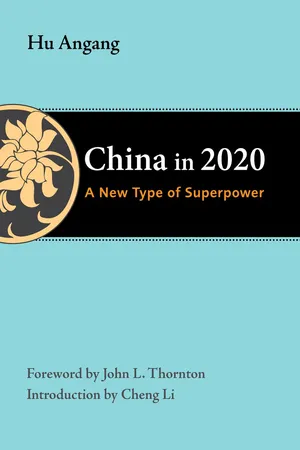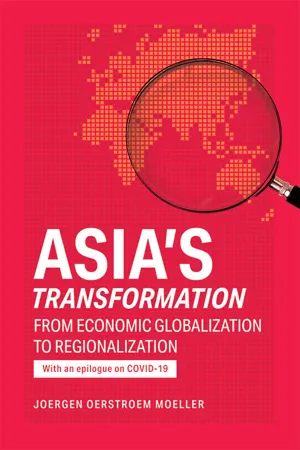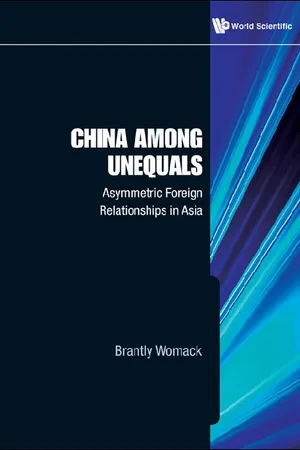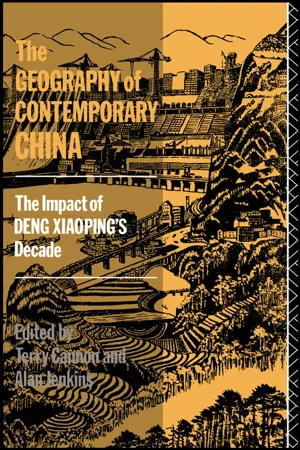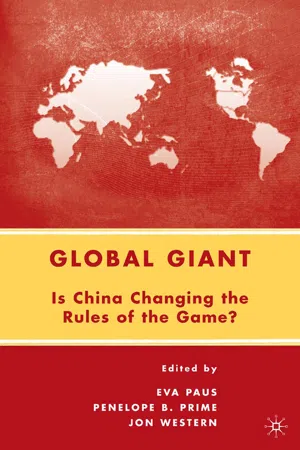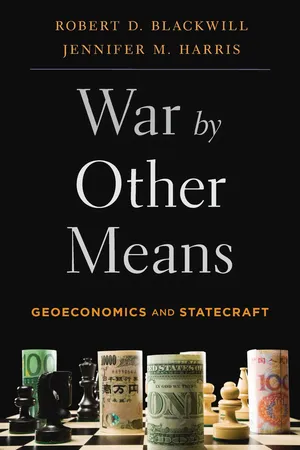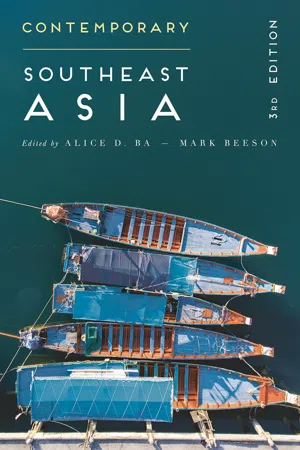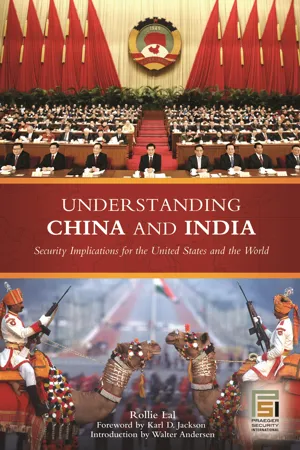Geography
China Superpower
China is a global superpower with a significant impact on geopolitics, economics, and trade. It is the world's most populous country and the second-largest economy, with a rapidly expanding influence in international affairs. China's geographic location, with access to both the Pacific Ocean and various land borders, contributes to its strategic importance and influence as a superpower.
Written by Perlego with AI-assistance
Related key terms
1 of 5
9 Key excerpts on "China Superpower"
- eBook - PDF
China in 2020
A New Type of Superpower
- Angang Hu(Author)
- 2011(Publication Date)
- Brookings Institution Press(Publisher)
Before discussing when China will be a superpower and what kind of superpower it will be, one must first delineate the meaning of the term super-power . There is no clear consensus on the definition of the term, but people tend to base their judgment on the following factors: 5 10 15 20 25 30 35 1 1000 1500 1600 1700 1820 1870 1900 1913 1950 1973 1980 1990 2000 2003 2030 Figure 1-1. Gross Domestic Product, Four Major Powers, Selected Years, 1–2030 China Western Europe Japan United States Percent of world total Source: Angus Maddison, “Statistics on World Population, GDP, and per Capita GDP, 1–2003 AD” (www.ggdc.net/maddison/); Angus Maddison, Chinese Economic Performance in the Long Run, 960– 2030 AD (Paris: OECD, 2007). china, an emerging superpower 13 —Culturally, the superpower must be tolerant, making possible the sur-vival and development of all civilizations. —Geographically, it must feature vast land or sea territories. —Economically and financially, it must be extraordinarily powerful. —Demographically, it must have a large number of well-educated citizens and a well-developed infrastructure. —Militarily, it must possess a unified military power that is relatively inde-structible, capable of preventing or causing huge destruction, and able to pro-ject its influence across the globe. —Politically and ideologically, it must have a powerful political system capable of efficiently allocating resources to realize its global political objec-tives and to exert influence via ideology. Of course, these six factors do not exhaust the possible factors that make a country a superpower. In my opinion it is more important to be able to identify which countries are superpowers than it is to provide a detailed and comprehensive definition of the term. Without a doubt, the only superpower in the present-day world is the United States. If China overtakes the United States in several important ways, then China will also be a superpower. - eBook - PDF
Asia's Transformation
From Economic Globalization to Regionalization
- Jørgen Møller(Author)
- 2020(Publication Date)
- ISEAS – Yusof Ishak Institute(Publisher)
137 8 The Power Game in Asia China Versus the US Regional Powers 1 An objective of superpower grand strategy is to be seen as strong enough to win a major war, thus precluding the need to actually fight. To make such a policy credible in the eyes of rivals and challengers, the financial strength of the power needs to be solid enough to sustain a protracted war. This includes keeping trade routes open, as a superpower cannot rely over the long term on its domestic resources and production capacity alone. China and the United States have pursued grand strategies that are similar in purpose, but the economic structures, geography and financial constraints limit the global ambitions for each. Economically, China is much more dependent on access to the global economy than the United States is. China cannot feed itself— the United States is a net exporter of food. China is the largest net importer of fossil fuel—in a couple of years the United States will be a net exporter. China’s share of exports/imports to GDP is around 18 per cent—for the United States the figure is around 12–14 per cent (on account of the deficit in the balance of payments, the figure is higher for imports than for exports). According to the OECD, China’s outward FDI stands at 14 per cent of GDP and its inward FDI at 21 per cent—the corresponding figures for the United States are 32 per cent and 36 per cent. 2 The United States has been a global investor (outward and inward) for more than a hundred years—China has only 138 Asia’s Transformation: From Economic Globalization to Regionalization participated in this for a couple of decades, which illustrates how quickly China has been building an international investment position. Geography requires that continental and maritime superpowers react differently to this quandary. A continental superpower, like the former Soviet Union, relies on its neighbours for overland transport links— railways or trucks. - eBook - PDF
China Among Unequals: Asymmetric Foreign Relationships In Asia
Asymmetric Foreign Relationships in Asia
- Brantly Womack(Author)
- 2010(Publication Date)
- World Scientific(Publisher)
Lastly, because of the comprehensive scope of this essay, not all relevant works could be addressed or footnoted, and I apologize for that. Originally published as “China between Region and World,” China Journal no. 61 (January 2009), pp. 1–20. region-state, not simply because of its size, but because its bound-aries conform to a natural economic region, its internal structure is clearly differentiated and its localities have distinctive external relationships. China is also unique as a multiregional power. Looking across the Pacific, the United States sees China primarily as an East Asian power, but within Asia there are different regions: Northeast Asia, Southeast Asia and Central Asia, and China is a leading participant in all of these. The significance of China as a regional power is more than the sum of its various regional roles, because multiple memberships in regional organizations influence its posture in each one. Lastly, China is a major economic and political presence in an increasingly complex global environment. Although the United States remains the central world power, global interactions are not entirely mediated through the center. For every country in the world, China now looms on the horizon as a major opportunity and challenge. It has become one of the major nodes in a multinodal world. The cur-rent weakness of the US fiscal system and the uncertainties of the world economy are likely to strengthen this trend. China does not rival the United States as a global power in terms of national wealth per capita or in military strength, nor is it likely to do so in the fore-seeable future, but its multipolar foreign policy is well adapted to a global situation in which it must cooperate with its partners rather than attempt to dominate them. China as a Region-State In the broadest sense of the term, a region is a geographical cluster whose members are interactive but not homogeneous and which is part of a larger but less cohesive whole. - eBook - ePub
The Geography of Contemporary China
The Impact of Deng Xiaoping's Decade
- Terry Cannon, Alan Jenkins(Authors)
- 2002(Publication Date)
- Routledge(Publisher)
Are such geopolitical issues still relevant in a nuclear age? Clearly they are, given that all military conflicts except one have been non-nuclear. The geopolitical factors described above have been one element in shaping all China’s conflicts since 1949. For example, there is some evidence that in conflicts with the Soviet Union in 1962 and 1969 both states tried to encourage minority grievances. There is also evidence that they both limited these conflicts, seeing that minority unrest could threaten control of ‘their’ minority peoples.Mention of nuclear issues brings out one of the dangers of a geopolitical analysis—that of assuming a static ‘geography’ shaping state policy. The internal geography of the country changes: for example, Tibet’s connections with the rest of China have been greatly altered by new roads built since 1959. So has China’s geostrategic position with respect to other states. The development of long-range nuclear bombers and intercontinental missiles means that China is both threatened by the nuclear powers and can threaten other countries. Thus China’s effective position with respect to other states has been changed significantly by nuclear weapons.Other, often longer-term, changes have also transformed China’s leader’s perception of its location. Historically, China was relatively isolated from other major powers and civilisations. It saw itself as Middle Kingdom (Zhong Guo), central to the world. But from the eighteenth century China had to confront other states which were culturally and militarily powerful. Since then, its leaders have had to operate on the basis that their country is, like others, subject to threats from near and far.Indeed, in the twentieth century, China has been located geostrategically between Russia as a developing power in Asia, and the United States emerging as a Pacific power. Moreover, Japan—once culturally subordinate to China—emerged to colonise and invade China until 1945. Thus without even considering the impact of nuclear weapons, China’s view of its place in the world has profoundly changed. Later in the chapter we will return to these wider questions. First, let us consider the extent of China’s legitimate claims to territory, as seen by the post-1949 leadership. This issue remains crucial to an analysis of China in the 1990s. - eBook - PDF
Global Giant
Is China Changing the Rules of the Game?
- E. Paus, P. Prime, J. Western(Authors)
- 2009(Publication Date)
- Palgrave Macmillan(Publisher)
To be a superpower, a state requires not only hard power but soft power as well. Hard power consists of economic and military strength that is often drawn from its national endowment such as population, territory, and natural recourses. Among all these variables, economy is the most dynamic and critical one, and that’s why this chapter limits its discussion of hard power to economic factors. The military aspect was left out for two reasons: first, more often than not, military strength is a function of the economy: when the later grows the former follows (Japan and Germany are all exceptions owing to the extraordinary postwar arrangement); sec- ond, the value of assessing Chinese military power by amateurs/outsiders is dubious due to the lack of reliable data, which is in turn due to the lack of transparency of the Chinese military. Aside from the hard power, how- ever, there is a different kind of power, the soft power that is indispens- able for being a great power. In the following paragraphs I will consider some major deficiencies in China’s soft power that remain a roadblock for China’s march toward superpower status. Two Tigers Living in the Same Mountain? 225 Soft Power If China is still far from becoming a superpower in terms of its hard power, then it is even further away in terms of soft power. First of all, China does not have a transcendent ideology. As French President Nicolas Sarkozy poignantly noted, a country without an ideology to export cannot be a great power. China not only lacks an ideology for export, it does not even have one for domestic consumption. Marxism has long been abandoned not only by the people but also by the Communist Party itself, which keeps its name only for the sake of legit- imacy. - eBook - PDF
- S. Breslin(Author)
- 2007(Publication Date)
- Palgrave Macmillan(Publisher)
5 Interpreting Chinese ‘Power’ in the Global Political Economy In Chapter 1, I argued that conceptions of Chinese power vary depending on what approaches are deployed to studying China. Approaches that emphasise the importance of commodity driven production networks like the previous Chapter will generate very dif- ferent conclusions from those that instead focus on states as the unit of interaction, and states as the unit of analysis. Where you are writing from (or for) appears to be an important determinant of con- clusions. This is partly because different analytical approaches dom- inate in different parts of the world – but that is not the only reason. Within East Asia, the growth of the Chinese economy has already had a profound impact on both the structure of the regional political economy, and on the developmental trajectories of individual regional states. The significance of China is clear and present (though whether significance equates to power is a different matter), and the final section of this Chapter will discuss how China’s re-engagement with the global economy has helped reconfigure the East Asian regional economy (and the economies of individual regional states as well). The conception of China as a threat is also much more evident in the US than it is in Europe, and the majority of the literature pre- dicting a future Chinese superpower challenging US power emerges from writers based in the US, largely intended to influence US policy makers. So before going on to question the basis of many under- standings of Chinese economic power, the Chapter begins by con- sidering the debates over whether to engage or to contain China – a debate that still persists (particularly in the US) despite the convic- tion of many observers that this dichotomous debate has become obsolete. 131 S. Breslin, China and the Global Political Economy © Shaun Breslin 2007 - eBook - PDF
War by Other Means
Geoeconomics and Statecraft
- Robert D. Blackwill, Jennifer M. Harris, Jennifer M. Harris(Authors)
- 2016(Publication Date)
- Belknap Press(Publisher)
Like military power, geoeconomic sway can carry a long shadow of influence. It need not be exercised or even brandished to register a de-sired effect. According to press reports, some energy companies drilling in the disputed South China Sea have publicly admitted to the necessity of partnering with Chinese state-owned energy firms so as not to be harassed. 6 The fact that the China Development Bank and Brazil’s BNDES have port-folios larger than the World Bank’s means that these states can wage diplo-macy with capital on a scale largely unmatched within the West. 7 This influence tends to be subtle—more often correlation patterns than clear causal arrows. But it is nonetheless real. At the same time, geoeconomic success is sometimes exaggerated, in-cluding with respect to China. There are natural limits and internal ten-sions running through many of Beijing’s attempts to use geoeconomics to advance geopolitical aims. It is possible that China’s ability to employ such instruments will be increasingly hampered by domestic problems—housing and stock market bubbles, a weak social welfare system, reform of the hukou (household registration) system, government corruption. 8 Powerful, protectionist-leaning industries and agencies have added to their domestic political power in recent years, strengthened by absorbing the preponder-ance of China’s post-financial-crisis stimulus. In China, just as anywhere else, the pursuit of geopolitical objectives and the importance of purely economic interests can clash, and these actors, newly emboldened, seem less willing to be trumped by geopolitical needs. There are regional chal-lenges, too. China’s heavy dealing has sparked a collective desire on the part of Southeast Asian states to achieve a measure of balance by drawing closer to the United States. In China’s case, geoeconomic power, like most other forms of power, may well prove most effective when implied rather than exercised outright. - eBook - PDF
Contemporary Southeast Asia
The Politics of Change, Contestation, and Adaptation
- Alice D. Ba, Mark Beeson, Alice D. Ba, Mark Beeson(Authors)
- 2017(Publication Date)
- Red Globe Press(Publisher)
Heightened tensions sur-rounding these overlapping claims especially since 2010 have also resulted in physical and diplomatic stand-offs at sea and in regional multilateral fora. As recent developments illustrate, when proximity meets growing power asymmetry, China becomes even more difficult to ignore for those who exist in its shadow. Southeast Asia’s geographic proximity to a larger China has also compli-cated the region’s major power challenges in other respects. Specifically, as a magnet attracting other major powers – many from far away – to South-east Asia, China has also been directly linked to the overlays of major and extra-regional competition found in Southeast Asia in the modern era. For example, moved by imperial ambition and the China trade, Western powers set up shop, expanded and eventually colonized Southeast Asia during the era of Western imperialism. Later, proximity to China similarly played a role in attracting major power competition to Southeast Asia during the Cold War. Against the backdrop of growing US–Soviet tensions, the perceived loss of China in 1949 and then the Korean War in 1950, Southeast Asia came to be attached with great geopolitical and ideological significance. The result was the extension of the Cold War and its major power conflicts to South-east Asia. Today, some worry that history may be repeating itself through new major power competition, this time between China as a rising power and those – namely the United States and Japan – who see China’s growth as a challenge to their own place and position in East and Southeast Asia. If geographic proximity makes Southeast Asia more acutely aware of China as a large power, it also makes China, compared to other powers, more interested in what happens in Southeast Asia as part of its ‘backyard’. - eBook - PDF
Understanding China and India
Security Implications for the United States and the World
- Rollie Lal(Author)
- 2006(Publication Date)
- Praeger(Publisher)
C H A P T E R 4 Globalization, Geopolitics, and Sovereignty Ruoguo Wuwaijiao—There is no diplomacy for weak countries —Chinese Proverb Introduction In determining why states do what they do, the forces of globalization and geopolitics cannot be ignored. Globalization’s increasingly rapid international exchange of information, trade, and technology, along with the accompanying economic interdependence, means that countries must adapt, as never before, and incorporate change or risk becoming obsolete. Competitiveness in these areas translates into power, whether economic or otherwise. The geopolitical implication is that in a world where the most powerful reigns, increased competitiveness leads to improved leverage. Respondents felt that India and China must acquire international standards of technology and economic might to protect and enhance their state sovereignty as a result of the increased emphasis on international competitiveness in a globalized world, and its impact on geopolitical power dynamics. Chinese and Indian respondents perceived the implied threats of the forces of globalization and geopolitics as critical to the pro- tection of state sovereignty. For instance, both sets of respondents cited the Iraq War and the Gulf War as examples of the use of high-technology weaponry to infringe upon state sovereignty. However, whereas to the Chinese respondents sovereignty referred mainly to territorial issues such as Taiwan, for the Indian respondents, sovereignty in the international political and economic arenas was considered of much higher impor- tance. Both countries’ respondents felt that pursuing a defense modern- ization program and an economic modernization program would lead to greater capabilities to protect their sovereignty in these areas. For Chinese respondents, globalization meant that defense technology and capabilities were constantly being eroded by new innovations in defense weaponry.
Index pages curate the most relevant extracts from our library of academic textbooks. They’ve been created using an in-house natural language model (NLM), each adding context and meaning to key research topics.
